Compass Reading
You can use the compass function to determine the direction of north, and to check your bearing to a destination.

Important!
Check the information at the link below to find out how to ensure correct readings.
Taking a Compass Reading
-
Display the current time screen.
-
Use (A) and (D) to select [COMPASS].
-
Press (C).
-
Move your arm in a figure eight.
-
Keeping the watch level, point 12 o’clock in the direction of your desired objective.
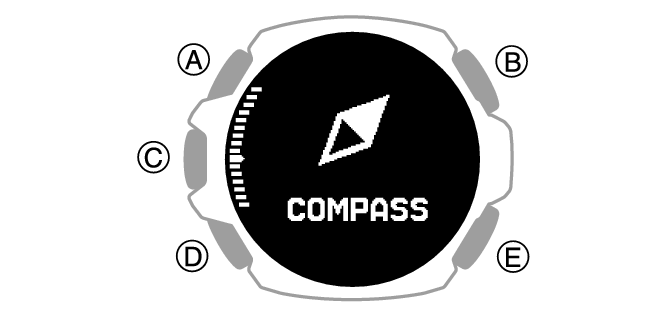
This displays [![]() ] in the bearing display area.
] in the bearing display area.
This normally causes [![]() ] to disappear and starts compass measurement.
] to disappear and starts compass measurement.
If [![]() ] does not disappear, perform bearing calibration.
] does not disappear, perform bearing calibration.
North is indicated by 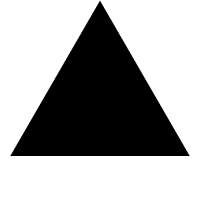 . The bearing and bearing angle to your objective will also appear on the display.
. The bearing and bearing angle to your objective will also appear on the display.
To retrigger the compass operation, press (C).
Interpreting Bearing Readings
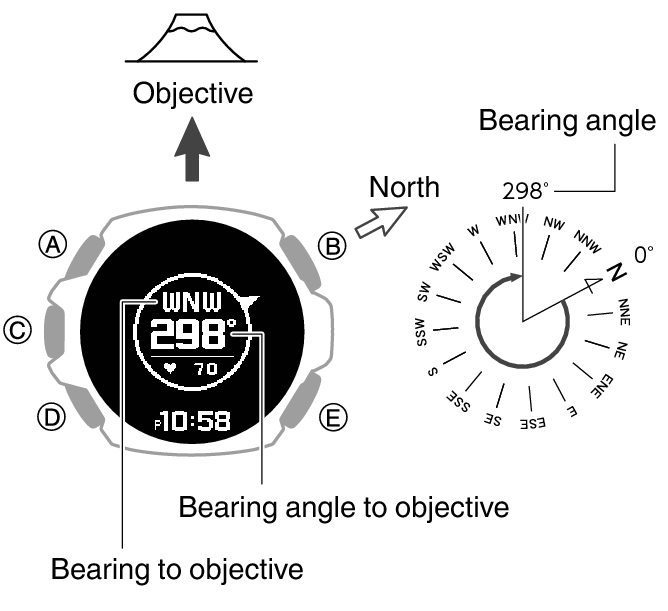
Directions: N (North), E (East), W (West), S (South)
Note
Normally the compass indicates magnetic north. You can also configure settings to indicate true north.
After the initial reading is displayed, the watch continues to take readings about every second for about 60 minutes.
The watch automatically returns to the current time screen if you do not perform any operation for about one hour during direction reading.
Aligning a Map with Actual Surroundings (Setting a Map)
Setting a map means to align the map so the directions indicated on it are aligned with the actual directions of your location. Once you set a map, you can more easily get a grasp of the relationship between map markings and actual geographic contours. To set a map with this watch, align north on the map with the north indication of the watch. Once you set the map, you can compare your bearing on the map with your surroundings, which will help you determine your current location and destination.
Note that map reading skills and experience are required to determine your current location and destination on a map.
Calibrating the Compass
Your watch constantly performs direction correction with the Watch Mode compass function and in the Activity Mode.
If [![]() ] is displayed in the direction display area, move your arm in a figure eight.
] is displayed in the direction display area, move your arm in a figure eight.
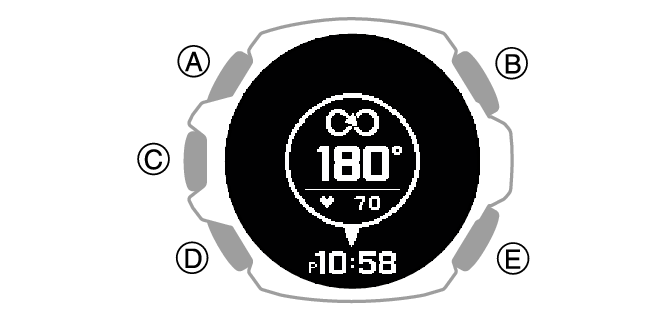
If [![]() ] is still displayed, follow the steps below to perform direction correction.
] is still displayed, follow the steps below to perform direction correction.
Calibrating Compass Readings
In order to ensure that the watch is performing direction measurements correctly, be sure to perform figure 8 calibration whenever the measurement results produced by the watch are different from readings produced by another compass. You should also perform figure 8 calibration before setting out on a climb.
Note that accurate compass readings and/or calibration will not be possible in an area where strong magnetism is present.
-
Display the current time screen.
-
Use (A) and (D) to select [COMPASS].
-
Press (C).
-
Hold down (A) for at least two seconds.
-
Use (A) and (D) to move the pointer to [FIGURE 8].
-
Press (C).

This displays the direction measurement setting screen.
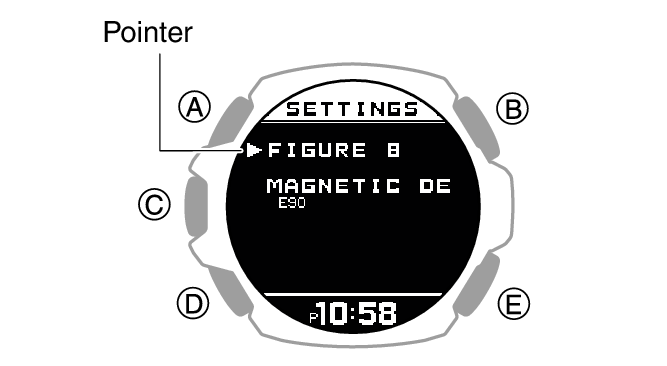
This displays the figure 8 calibration screen.
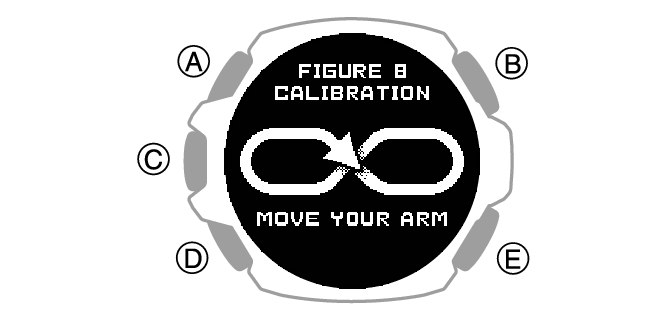
When the screen shown above appears, move your arm in a figure 8 pattern as shown in the illustrations below.
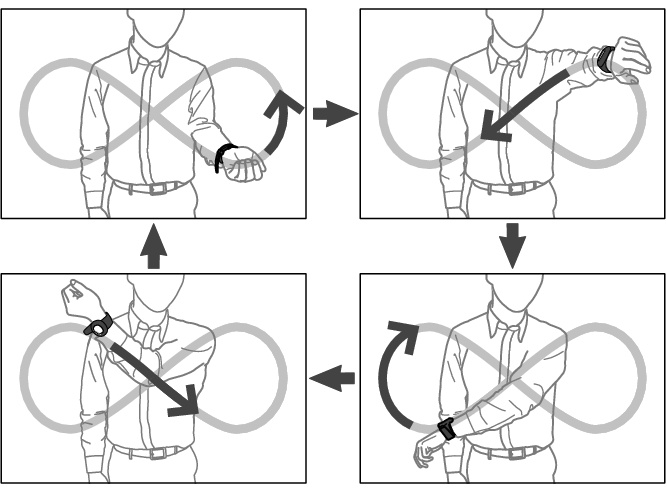
Allow your wrist to twist.
Keep your arm as far as possible from your body as you move it.
After calibration is successful, a check mark appears for a few seconds, and then the setting screen re-appears.
Note
The message [FAILED RETRY?] appears on the display if calibration fails.
Press (A) or (D) to select [YES] (Re-calibrate) or [NO] (Stop calibration), and then press (C).
To return to the direction measurement setting screen during the above procedure, press (E).
Setting Up for True North Readings (Magnetic Declination Calibration)
If you want the watch to indicate true north instead of magnetic north, you need to specify your current location’s magnetic declination direction (east or west) and declination angle.
The magnetic declination angle value can be set in 1° (degree) units only. Use a value that is closest to the angle you want to set.
Example: For an angle of 7.4°, set 7°.
Example: For an angle of 7°40’ (7 degrees, 40 minutes), set 8°.
Note
Magnetic declination angles (east or west) and angle degree values for specific locations can be found on geographic maps, mountain climbing maps, and other maps that include contour lines.
-
Display the current time screen.
-
Use (A) and (D) to select [COMPASS].
-
Press (C).
-
Hold down (A) for at least two seconds.
-
Use (A) and (D) to move the pointer to [MAGNETIC DECLINATION].
-
Press (C).
-
Press (A) (West) or (D) (East) to change the magnetic declination direction and angle.
-
Press (C) to complete the setting operation.
-
Hold down (E) for at least one second to return to the current time screen.

This displays the direction measurement setting screen.

Setting range: 90° west to 90° east
|
[0° (OFF)] |
Magnetic north |
|
[E] |
Magnetic north east of true north (East declination) |
|
[W] |
Magnetic north west of true north (West declination) |
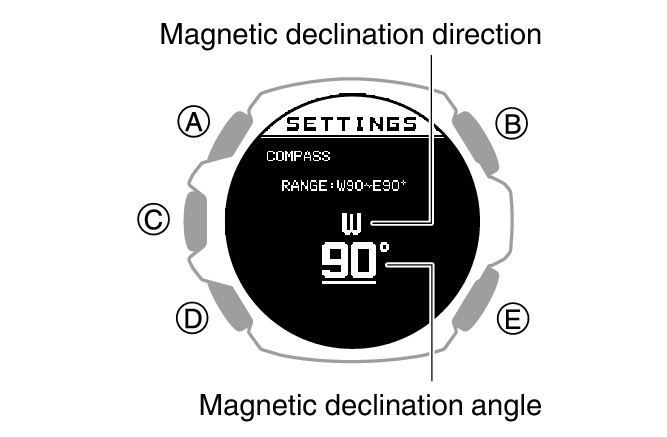
To stop the setting operation, press (E) and advance to step 9.
After the setting operation is complete, a check mark appears for a few seconds, and then the bearing measurement setting screen re-appears.
Magnetic North and True North
There are actually two types of north: magnetic north and true north.
Magnetic north: North indicated by the needle of a compass
True north: Direction to the North Pole
As shown in the illustration below, magnetic north and true north are not the same.
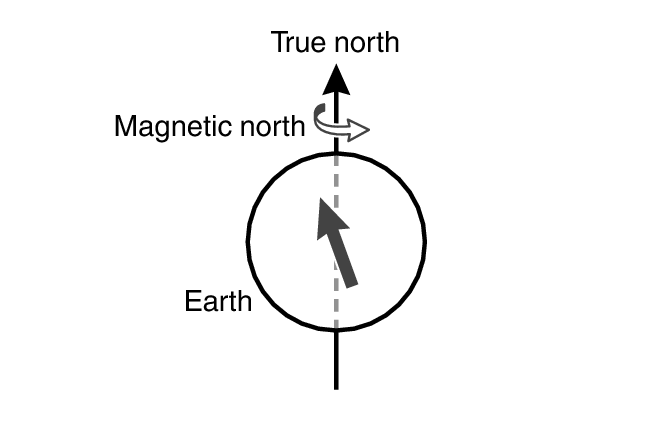
Note
The north indicated on commercially available maps is normally true north.
Digital Compass Reading Precautions
Location During Use
Taking readings near sources of strong magnetism can cause reading error. Keep the watch away from the following types of items.
Permanent magnets (magnetic accessories, etc.), metal objects, high-voltage wires, aerial wires, electrical household appliances (TVs, computers, cellphones, etc.)
Note that correct direction readings are not possible indoors, especially inside of reinforced concrete structures.
Accurate direction readings are not possible on electric trains, on boats, on aircraft, etc.
Storage Location
Exposure of the watch to magnetism can affect the accuracy of digital compass readings. Keep the watch away from the types of items below.
Permanent magnets (magnetic accessories, etc.), metal objects, electrical household appliances (TVs, computers, cellphones, etc.)